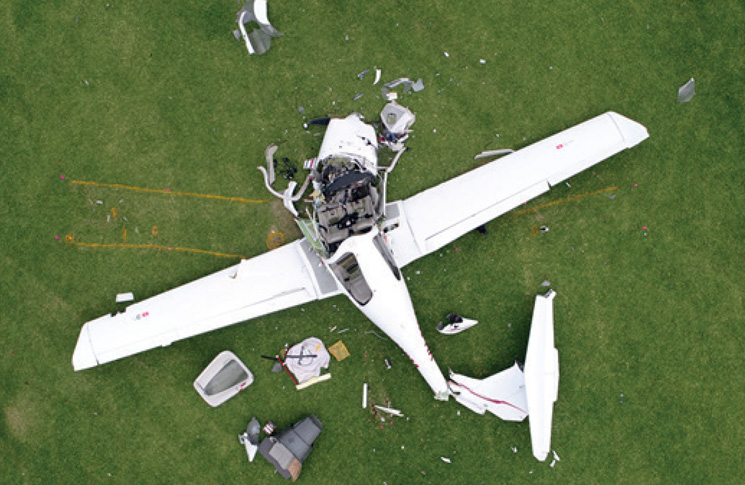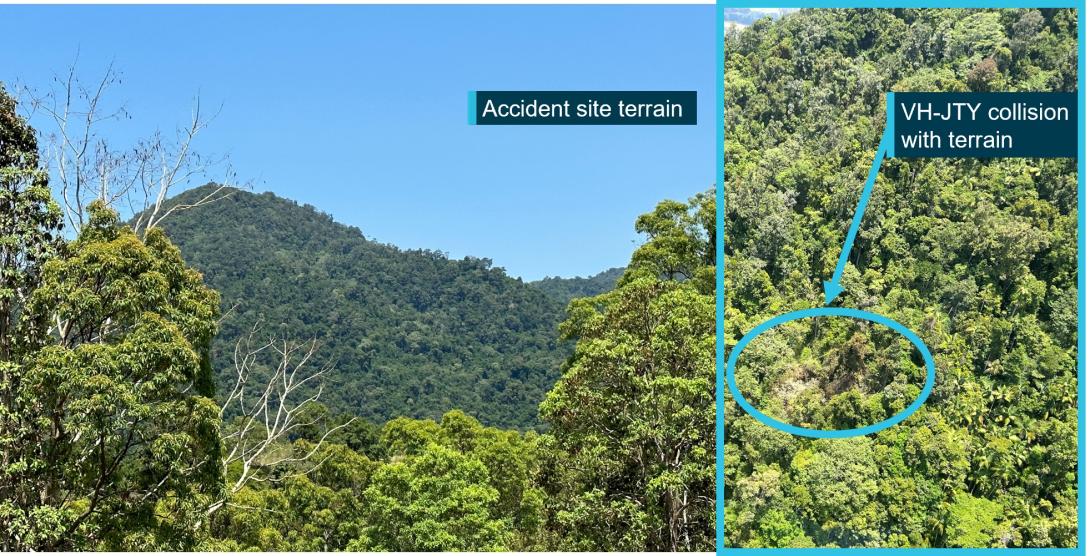The Australian Transport Safety Bureau (ATSB) has warned of the danger of conducting incipient spin training in aircraft not approved for intentional spins, after its investigation into the deaths of an instructor and student in Queensland in 2017.
The two men were on training flight in 26 September 2017, in a single engine Diamond DA40, taking off from Archerfield Airport, Queensland. The purpose of the flight was a simulated Recreational Pilot Licence (RPL) flight test to prepare the student for his RPL flight test.
In the words of the ATSB report, ‘The aircraft entered a developed spin during manoeuvres consistent with advanced stall recovery training which likely included intentional incipient spins. The spin continued until the aircraft collided with terrain.’
The instructor and student were killed, and the aircraft was destroyed.
An incipient spin that is not allowed to develop into a fully developed spin is commonly used as an introduction to spin training and spin recovery techniques.
Doing an incipient spin in an aeroplane that is not approved for spinning takes the aeroplane outside its normal operating envelope. When this happens, the aircraft is flying in the safety margins provided by the aeroplane certification standards for airframe structural integrity and demonstrated ability to recover from the manoeuvre.
However, the ATSB found there was no strict definition of where an incipient spin became developed, or of when spin entry became an incipient spin.
‘While CASA requires the demonstration of recovery from an incipient spin during flight tests, there is no clear and consistent definition of the point at which a manoeuvre becomes a spin—or incipient spin—for the purposes of flying training,’ the ATSB said.
The ATSB found that the aircraft limitation prohibiting intentional spins was intended to include incipient spins. However, the manoeuvre was not defined and some operators considered that the manoeuvre was not an intentional spin.
In addition, the aircraft was not certified for developed spin recovery, and the capability of the aircraft to recover from a developed spin had not been established nor was it required to be.
The ATSB found the instructor could not or did not prevent the aircraft from entering a developed spin, for reasons that could not be established.
The ATSB has issued a Safety Advisory Notice to advise training organisations to clarify with aircraft manufacturers the extent to which the intentional entry into the early stages of a spin, including an incipient spin, is permissible.
The DA40’s certification report stated that the aircraft exhibited prompt incipient spin recovery behaviour within the certification requirements. But Diamond was not required to and did not test the aircraft for fully developed spin behaviour and recovery.
The aircraft flight manual included a limitation stating that intentional spinning was not permitted in the aircraft.
Diamond told the ATSB, ‘The DA40 used in this accident is not approved for intentional spins, incipient or otherwise. Inducing a spin is outside of the approved envelope of the DA40.’
‘Using rudder deflection to enter an incipient spin, even if the aircraft is immediately recovered from that incipient spin, is an intentional spin and therefore not allowed to be performed with a DA40.’






My question here is; was the instructor proficient in the recovery from a fully developed spin? I was lucky enough to have to be able to recover from a fully developed spin when I was doing my training in 1965.
I still maintain that all student pilot should be able to demonstrate recovery from abnormal attitudes before the issue of their licences.
I have seen instructors who are not happy doing stalls!!!
I agree David but what I do find very perplexing is the fact any aircraft can be certified that cannot be spun, which I consider to be rather dangerous because of the possibility that under the right circumstances, any aircraft can enter a stall or a spin accidently, e.g. if a pilot performing a climbing turn and not paying proper attention to the airspeed allows the airspeed to drop to a dangerous level which could put the aircraft into an unintentional spin for instance!
Completely agree how this aircraft can be certified with no basic recovery capabilities ??
sadly it need never have happened:-( Ultimately the authorities handed these two guys a loaded gun, now go fondle the trigger whilst pointing it at yourself!
Rarely post but am prompted that there is one Australian training aircraft that while not approved for spins, during certification had demonstrated a reluctance to spin and also demonstrated good spin recovery.
Perhaps the spin certification requirements should be expanded and then noted, may use up a few spin recovery parachutes but for the greater good.
Am I to understand that if, for whatever reason – intentional or otherwise, this aircraft cannot recover from a spin? Why would anyone invest their money purchasing such an unforgiving aircraft?
Phoenix there are plenty aircraft that are not approved for spins. From light aircraft to big corporate jets.
Most aircraft are not approved for intentional spinning, mainly due to the stresses induced in the airframe during recovery. However i firmly believe that an aircraft that cannot recover from an accidental spin should only be permitted in the experimental category. diamond need their arses sued off them
I agree with most of the comments above in my training days we did not get our license if we could not demonstrate our ability to recover from a spin, using aircraft that were authorised to spin of course. All aircraft can spin if put in the wrong situation, it is to teach the student what is the wrong situation, using an instructor who knows how! The RAAA is reported to be making moves for all the RAA instructors to go through spin training ( God help them )
In some ways we are going about this all wrong! Most accidents that involved an unintentional spin would have been unrecoverable anyway due being too low, IE in the circuit by poor handling. It’s more about education, proper training and making sure a pilots license is earned and not handed over cause enough money has been paid! I’ve said it before it’s too easy to get a pilots license these days, make it a lot harder as well as the checking once license been in force for a while. Aerobatic training is an excellent way to obtain the skills for recovery from unusual attitudes but only in the proper machine at the appropriate height, not whilst turning final or after take off with poor flying skills! Stay safe out there, stay alert!
I followed this story closely and was amazed that it took a tragedy like this to highlight this very common approach taken by a number of flight schools where instructors perform incipient spins in aircraft that are categorically not certified for one.
Case in point – Soar Aviation’s Aquilas were being flipped one turn during the PPL/CPL flight-test and I was fairly vocal about my criticism given the Aquila A210’s Flight Manual states it is not approved for spinning. Not surprised they’ve now lost their RTO status too.
The da40 while not approved for INTENTIONALLY spinning or spin recovery training, is able to recover from a spin. There is a video on YouTube of diamond testing the spin recovery of this aircraft and it was very capable. At least during testing anyways. As for why it was never certified for intentionally spinning I don’t know. Perhaps the load factors and stresses on the aircraft, or the amount of altitude lost during the spin and recover maybe? But look up the video. It’s was not an unrecoverable plane providing it had suitable altitude. Perhaps with a full takeoff weight it made things more difficult or CofG. I fly the Da20 regularly which is a utility category aircraft that is approved for spin training and it is an critical part to pilot training in my opinion that a student pilot should see and feel spins and learn the recover. Not just from an incipient spin but fully developed as well
I’m a firm believer in not forcing an aircraft to do something it doesn’t want to do. The intention of spin and stall training in the PPL/CPL training is recognition and avoidance. In my experience way too little time is spent on slow flight, wing drop and other UPRT recognition, and immediate recovery.
It is not as simple as that. A well trained pilot can be a victim of a twitchy aircraft, and by twitchy I mean at slow speed, in the turn, flicking a wing and nose down before you can blink. Approaching a circuit at night, looking for the aerodrome lights ( now is it PAL or PAF AFRU, did I press it right , look at the chart again) looking looking then ouch, is my speed that low?. I have been there in an aircraft that is very very safe in that situation. Is yours?